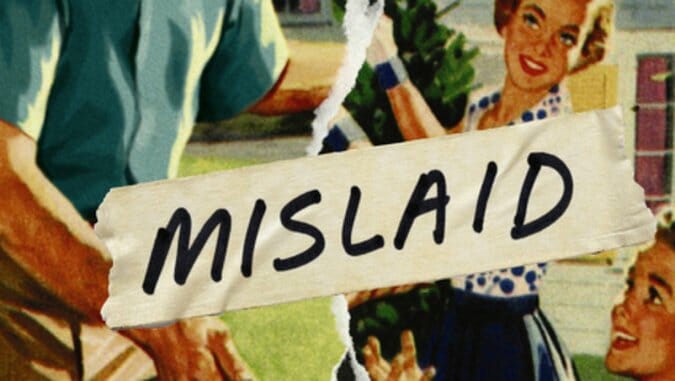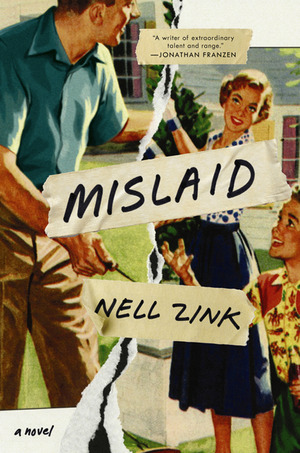
Nell Zink’s first published novel, The Wallcreeper, appeared last year as part of an independent micropress project called Dorothy. The book chronicles the marriage of two expatriate Americans that lurches illogically from thrilling “getting-to-know-you” sex to loathsome “familiarity-breeds-contempt” sex to adultery to resignation to dispassionate commitment, occasionally spiked with obsessive rare bird kidnapping and casual ecoterrorism.
 Unnervingly compelling, like a page-turner without a plot, The Wallcreeper plays out more like a fascinating character sketch than a story. But it should come as a great relief to anyone left wanting more that Zink’s next novel, Mislaid, arrives a scant eight months after the The Wallcreeper. And if anything, Zink packs Mislaid with almost too much story.
Unnervingly compelling, like a page-turner without a plot, The Wallcreeper plays out more like a fascinating character sketch than a story. But it should come as a great relief to anyone left wanting more that Zink’s next novel, Mislaid, arrives a scant eight months after the The Wallcreeper. And if anything, Zink packs Mislaid with almost too much story.
Mislaid begins in a small town in early-’60s Virginia, introducing Peggy Vallaincourt, the sexually ambivalent daughter of a boarding school chaplain who envisions her future combining thespianism, lesbianism and a stint in the armed forces—all against her mother’s better judgment.
Also to the disappointment of her mother, she chooses to attend nearby Stillwater College, where she soon falls in something like love with poet-in-residence Lee Fleming. Lee is a scion of local aristocracy and a gay man himself, but he’s intrigued to be having such fabulous sex with a coed. The novelty doesn’t last. In short order, Peggy finds herself pregnant, kicked out of school and married to a gay narcissist whose many famous-gay-poet friends frequent their house and show no more interest in Peggy than her husband does:
Even if they hadn’t all been gay men and thus more or less not interested in her at all, almost blind to her existence; even if they had been models of chivalry, rushing to pick up things she dropped and giving her flowers, instead of bullshitting parasites who thought they had invented crass vulgarity before inventing maudlin sentimentality as a foil (exposure to them was making Peggy at once articulate and sullen), a monosyllabic high school graduate in an oversized polo shirt with baby food on it was not going to get their attention.
Somehow, the marriage manages to survive a decade of detachment and dissipation, produce two children and cast Peggy into a fairly conventional role of 24-7 motherhood and domesticity, her youthful aspirations to lesbianism and thespianism long gone. Until one day she cracks and takes her three-year-old daughter and disappears, leaving behind Lee and their nine-year-old son.
Going underground with her daughter means forging new identities, with a birth certificate stolen from a deceased black child in Peggy’s hometown. Traveling deeper into rural Virginia, Peggy (now Meg) and her daughter (now Karen) move into a decaying house surrounded by standing water. They pass themselves off surprisingly easily as a black mother and her blond, black daughter, as Zink explains with typically acerbic wit:
Maybe you have to be from the South to get your head around blond black people. Virginia had settled before slavery began, and it was diverse… The only way to tell white from colored for the purposes of segregation was the one-drop rule: if one of your ancestors was black—ever, in the history of the world, all the way back to Noah’s son Ham—so were you.
What follows is a moderately paced, gently funny story about the two halves of this broken family and the trajectory of their kid’s almost impossibly different childhoods. Too young to remember much of anything about her father or brother, Karen never doubts that she’s a black girl two years older than her real age.
Mislaid shifts gears abruptly when the two siblings’ lives collide at the University of Virginia in a twist that at first seems almost ripped from the headlines (though those headlines hadn’t been written at the time Zink wrote it). Mislaid explodes into a rip-roaring, hold-onto-your-hat campus legal thriller at this point, rushing to wildly imaginative and unexpected places. Zink sends up the fabulist pretensions of Tom Wolfe’s I Am Charlotte Simmons as sharply as Percival Everett eviscerated the exploitative sensationalism of Sapphire’s Push in Erasure.
An article on Zink published earlier this year described how the author cranked out most of The Wallcreeper in about four days to prove to novelist Jonathan Franzen—who championed her work and found her an agent—that she could write a novel. Mislaid demonstrates that she can write several kinds of novel, and if the book appears to outrageously shift tempos, given how successfully Zink ratchets up the pacing and intensity after brother and sister unknowingly cross paths, it’s hard to imagine any readers complaining.
Ironic, harsh and sometimes corrosively cynical in tone, Zink writes with energetic, ecstatic abandon, with less of The Wallcreeper’s staccato edge in Mislaid. She delves fearlessly and credibly into race and gender issues, onloading on old Virginia in just-right didactic bursts. Zink develops peculiar and wonderful characters, and she writes situational humor (including sexual situational humor) with a deftness and ease it took John Irving twice as many books to master. Each of the book’s three surprise sexual awakenings plays out funnier than the last.
Zink shares a bit of Annie Proulx’s way with a skull-cracking verb, although she delivers bigger and more consistent off-kilter laughs along the lines of Percival Everett’s I Am Not Sidney Poitier. But mostly, Nell Zink writes like Nell Zink, which is the best news of all, especially if she continues to write this funny and this fast.